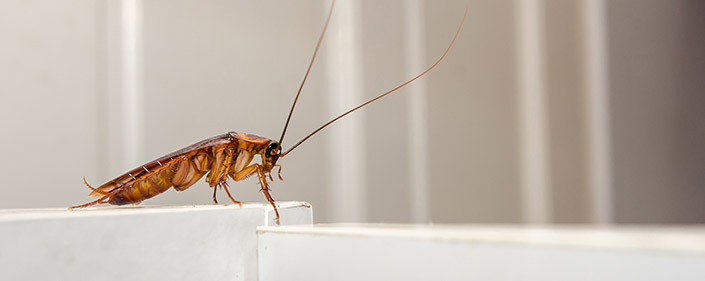Benefits of Using Our Service
- to Replace Traditional Toxic Pesticides
Cockroaches
Cockroaches are medium-sized to large insects in the order Dictyoptera (formerly Orthoptera). They are broad, flattened insects with long antennae and a prominent, shield-shaped section behind the head called a pronotum. Adult cockroaches have membranous wings. Immature cockroaches (nymphs) look like adults, but are smaller and do not have wings.
Management
Sanitation Practices
- Reduce food and water sources
- Store food in insect-proof containers such as glass jars or resealable plastic containers
- Eliminate plumbing leaks and correct other sources of free moisture. Increase ventilation where condensation is a problem
Life Cycle
An adult female cockroach produces an egg capsule, called an ootheca, which it carries around protruding from the tip of the abdomen. Young or immature cockroaches undergo gradual metamorphosis, which means they resemble adults and have similar feeding habits, but they do not have fully developed wings and are not reproductively active.
Immediately after molting, cockroaches are white, but their outer covering darkens as it hardens, usually within hours. Cockroaches are nocturnal. They hide in dark, warm areas, especially narrow spaces where surfaces touch them on both sides. Immature cockroaches tend to stay in even smaller cracks where they are well protected. Cockroaches tend to congregate in corners and generally travel along the edges of walls or other surfaces.
German Cockroach
Adult: 0.5 inch. Light brown, two dark stripes on pronotum
Preferred location: kitchens, bathrooms, food preparation and storage areas
The German cockroach, Blattella germanica, is the most common indoor species, especially in multiple-family dwellings. They prefer food preparation areas, kitchens, and bathrooms because they favor warm (21 to 24°C), humid areas that are close to food and water.
This species reproduces the fastest of the common pest cockroaches: a single female and her offspring can produce over 30,000 individuals in a year, but many succumb to cannibalism and other population pressures. Egg laying occurs more frequently during warm weather. The female carries around a light tan egg case (about 1/4 inch long) until 1 to 2 days before it hatches, when she drops it. Sometimes the egg case hatches while it is still being carried by the female. Each egg case contains about 30 young, and a female may produce a new egg case every few weeks.
American Cockroach
Adult: 2 inches. Reddish brown; large body, edges of pronotum are light colored
Preferred location: Sewers, water meter boxes, storm drains, steam tunnels, animal-rearing facilitie
The American cockroach, Periplaneta americana, prefers warm and humid environments, usually with temperatures in excess of 27°C. Under the right conditions, they readily live outdoors and are common pests in zoos and animal-rearing facilities. They are also common in sewers, steam tunnels, and masonry storm drains. Occasionally they forage from sewers and other areas into the ground floor of buildings.
Adult females carry the egg cases around for about 6 days and then cement them to a protected surface where they incubate for about 2 months or longer. The egg cases, which are about 3/8 inch long, are brown when laid but turn black in 1 to 2 days. Each egg capsule contains about 12 young; a female and her offspring can produce over 800 cockroaches in one year.
Australian Cockroach
Adult: body length about 3 cm; distinct light yellow streaks on the sides at the base of the wings, Periplaneta americana does not have similar yellow markings on the wings
Preferred location: drier areas like cupboards, storerooms
The Australian cockroach, P. australasiae is very similar in appearance to P. americana except for a lateral pale yellow stripe on the each of the forewings which is about a third of the length of the wings and of course the yellow margin around the pronotum. They are also slightly smaller, 27 – 33 mm long. They prefer temperatures which are warm, 30 °C.
The female lays an ootheca about 10 – 11 mm long which contains about 22 – 24 eggs in two rows of 11 or 12 which take about 40 days to hatch, but only 60 percent of this number usually hatch. Once hatched (see above) the nymphs moult 6 – 12 times depending on food, temperature and humidity. Females produce ootheca 20 days after maturation; produces 20 – 30 ootheca at 10 day intervals.
Johnson Group Cockroaches Control Service
Spot Treatment
Baits
Gel Bait can very effective for crack and crevice treatments, Apply gel using a bait gun or syringe in small dabs in cracks and crevices where cockroaches will find it. While they are fresh, bait gels are very effective when placed in locations where they will be found by cockroaches. To remain effective, however, the gels need to be reapplied frequently.
Baiting methods are slow acting. Consequently an effective bait program does not give immediate results, but may take 7-14 days or longer. Baits can be quite effective for long-term control of cockroaches unless the cockroaches have other food sources available to them.


